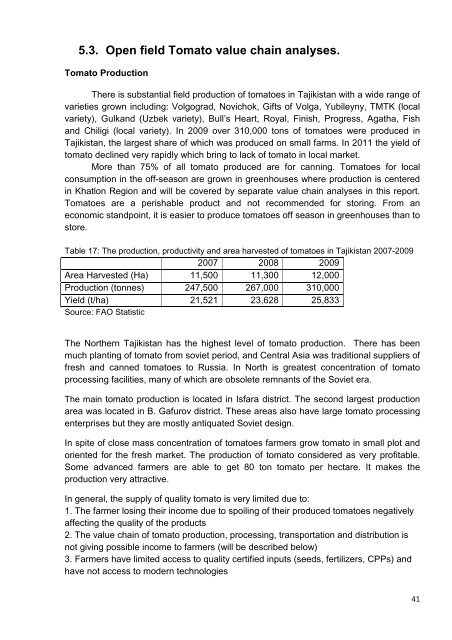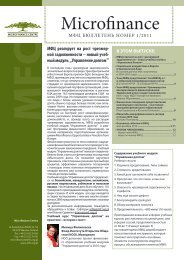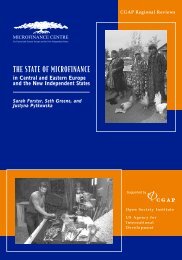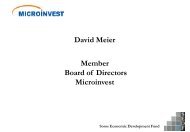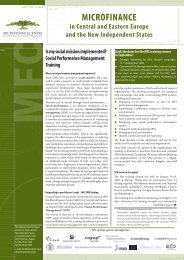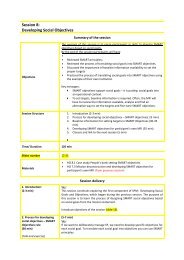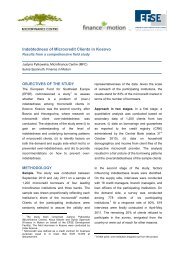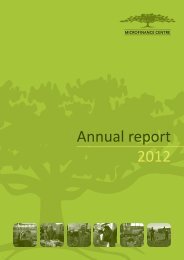Value Chains research report Tajikistan final - Microfinance Centre
Value Chains research report Tajikistan final - Microfinance Centre
Value Chains research report Tajikistan final - Microfinance Centre
Create successful ePaper yourself
Turn your PDF publications into a flip-book with our unique Google optimized e-Paper software.
5.3. Open field Tomato value chain analyses.<br />
Tomato Production<br />
There is substantial field production of tomatoes in <strong>Tajikistan</strong> with a wide range of<br />
varieties grown including: Volgograd, Novichok, Gifts of Volga, Yubileyny, TMTK (local<br />
variety), Gulkand (Uzbek variety), Bull’s Heart, Royal, Finish, Progress, Agatha, Fish<br />
and Chiligi (local variety). In 2009 over 310,000 tons of tomatoes were produced in<br />
<strong>Tajikistan</strong>, the largest share of which was produced on small farms. In 2011 the yield of<br />
tomato declined very rapidly which bring to lack of tomato in local market.<br />
More than 75% of all tomato produced are for canning. Tomatoes for local<br />
consumption in the off-season are grown in greenhouses where production is centered<br />
in Khatlon Region and will be covered by separate value chain analyses in this <strong>report</strong>.<br />
Tomatoes are a perishable product and not recommended for storing. From an<br />
economic standpoint, it is easier to produce tomatoes off season in greenhouses than to<br />
store.<br />
Table 17: The production, productivity and area harvested of tomatoes in <strong>Tajikistan</strong> 2007-2009<br />
2007 2008 2009<br />
Area Harvested (Ha) 11,500 11,300 12,000<br />
Production (tonnes) 247,500 267,000 310,000<br />
Yield (t/ha) 21,521 23,628 25,833<br />
Source: FAO Statistic<br />
The Northern <strong>Tajikistan</strong> has the highest level of tomato production. There has been<br />
much planting of tomato from soviet period, and Central Asia was traditional suppliers of<br />
fresh and canned tomatoes to Russia. In North is greatest concentration of tomato<br />
processing facilities, many of which are obsolete remnants of the Soviet era.<br />
The main tomato production is located in Isfara district. The second largest production<br />
area was located in B. Gafurov district. These areas also have large tomato processing<br />
enterprises but they are mostly antiquated Soviet design.<br />
In spite of close mass concentration of tomatoes farmers grow tomato in small plot and<br />
oriented for the fresh market. The production of tomato considered as very profitable.<br />
Some advanced farmers are able to get 80 ton tomato per hectare. It makes the<br />
production very attractive.<br />
In general, the supply of quality tomato is very limited due to:<br />
1. The farmer losing their income due to spoiling of their produced tomatoes negatively<br />
affecting the quality of the products<br />
2. The value chain of tomato production, processing, transportation and distribution is<br />
not giving possible income to farmers (will be described below)<br />
3. Farmers have limited access to quality certified inputs (seeds, fertilizers, CPPs) and<br />
have not access to modern technologies<br />
41


